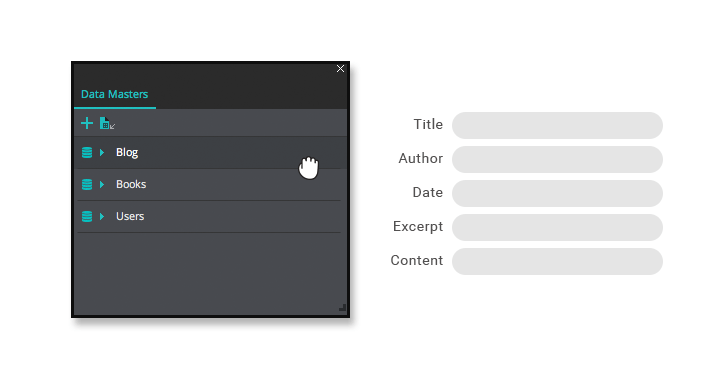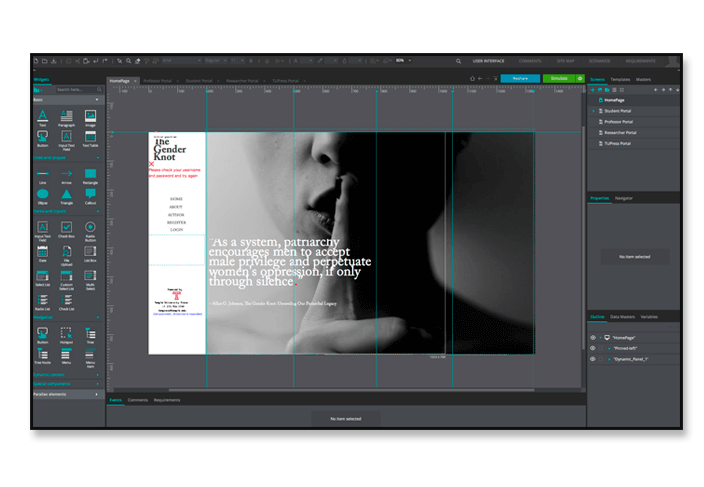Prototyping at Uni: redefining business analysis & design

We talked to Temple University about prototyping in the digital design syllabus, and it’s role as a rising star. Check it out!
In this day and age, it’s easy enough to make something new, but what really counts is making something better. On this note, the Management Information Systems Department at Temple University Philadelphia is revamping their traditional Digital Design course in order to create a process of defining business requirements as well as designing meaningful solutions.
In this post, James Moustafellos and Richard Flanagan, Assistant Professors of the MIS department, explain how making Justinmind an integral component of their course is bridging the gap between Design and Business Requirements at Temple University.
“Earlier prototyping wasn’t nearly as sophisticated and certainly not as integrative. We see Justinmind as a teaching tool and that’s why we’ve made it a required component of the course.” (James, Temple University)
Shifting priorities: the prototyping process
In their Digital Design and Innovation classes, the students learn the importance of understanding the problem prior to designing a solution. In today’s digital age, the growing emphasis on design is shifting the focus to solutions without truly understanding the problem.
In contrast, James and Richard’s classes have been working with live customers (real organizations or small businesses), analyzing their client’s goals and processes to come up with digital tools to increase performance, and help clients meet their business objectives.In teams of four or five, the students are required to complete an initial set of interviews intended to engage the client and teach the students how to assess the client’s objectives and identify possible weaknesses. And thus, by creating awareness of the client’s requirements, the students acquire the knowledge to contribute a meaningful solution.
They then spend the semester learning how to use Justinmind, building solutions in the form of interactive prototypes and then they present them to the department and finally to the client, at the end of the semester.
Learning to learn: the prototyping learning curve with Justinmind
“It’s all about learning how to solve the problem, and Justinmind does this very well.” (James, Temple University)
James and Richard use Justinmind to help their students conceptualize, visualize and ultimately design business solutions. Richard stresses that “prototyping is a thinking cognitive experience, for the designer”. As a characteristic of the learning curve, the professors don’t actually instruct their classes on how to use Justinmind. Rather, they teach the students to develop an idea into a palpable solution, using Justinmind’s interactive prototypes.
The syllabus involves lab time so that the students are directly exposed to wireframing, from early on in the course. The students learn how to use the tool through peer to peer interaction, with former-student teaching assistants, or individually, playing around with the tool, and watching Justinmind tutorials for additional guidance.
One of the current teaching assistants, Project Manager, and former Digital Design and Innovation student, Loi Tran, says that “Justinmind is just a helpful tool overall”. When Loi created his own Justinmind prototype earlier this year, it was his first time using a prototyping tool. He explains that Justinmind is easy to follow for first time users, which is essential for a self-taught class.
Richard explains that the students learn how to learn with Justinmind, which is an extremely valuable skill to master and carry with you through university, and indeed throughout life. The class is introduced to Justinmind within the first three weeks of the course and it typically takes them around three to four weeks, out of the 14 week semester, to wrap their heads around how it works.
Extra credit coursework assignments are offered to stimulate further prototyping outside of the classroom. The students perform exercises in class related to the coursework, and are then given a week to create a prototype on their own that’s somehow related to the in-class exercises. They work on three similar sets of exercises, with the idea being to introduce them to Justinmind before they get started on their final project.
That’s usually where the learning curve occurs and when they begin the final project, they can put what they’ve learned into practice. We’re all students of behavior, and as David Sherwin, Director of User Experience at Lynda.com, recognizes: “Design can solve society’s biggest problems, if we cultivate a love of learning through the design process.”
“What they need to do is learn how to learn a new tool, quickly. We consider this a very important aspect of learning for which Justinmind has been an integral element.” (Richard, Temple University)
First impressions
Loi says that the pre-installed widgets were particularly helpful to his learning experience with Justinmind. The libraries have an extensive selection of widgets to choose from, including Android Lollipop Widgets and iOS8 Icons.
“You can pull up each widget and see how it actually works and then recreate, redesign and retool it to do something else. The widgets are definitely a good add on.”
Another feature that has been used widely by the MIS students are the dynamic panels. With Justinmind’s Dynamic panels, they can customize dynamic content without having to switch between screens, capturing and holding the user’s attention for longer. They can also organize the panels so that the user is not overwhelmed with information.
Richard indicates that: “The first year we taught this course, I think only one student was using dynamic panels. Now, there are dynamic panels in everything. The % of the tool that’s being used has increased tremendously.”
Smarter is better: Justinmind goes the extra mile
“It changes the discussion. It’s a truly interactive, high fidelity prototype.” (James, Temple University)
According to James, Justinmind’s prototyping is “so sophisticated that it’s really paralleling what an actual app or website would do”, stating that his “students are amazed at how much they can do with Justinmind”.
They’re driven to experience their prototypes from the user’s standpoint and they’re pushed to consider more than just the appearance of a site or app, to really integrate business rules and use data in their smart prototypes.
As most are Business Analysis students, being able to integrate data and include conditions in their pages to simulate exactly how the business rules would work is especially important. By using Justinmind’s dynamic data lists, they’re able to transition from diagrams to importing data and keeping track of every single piece.
This enables in-depth class discussions about the inter-relationship of the rules and data in the actual design and construction of the site. The students learn why these are critical to their work, and also gain an insight into why collecting this information is useful. With Justinmind, they can also import real data from a data base, allowing them to fill their prototypes with all the necessary records.
“Justinmind has changed our teaching. The prototype incorporates all of the important aspects that we’re working on.” (James, Temple University)
Forgotten Philadelphia: from a mobile app mock up to a real-life app
Mary Rose Muccie, one of the student’s clients, is Director of Temple University Press, founded in 1969. The Press staff were interested in creating an app around a book, Forgotten Philadelphia. Written by Thomas H. Keels, and published by the Temple University Press in 2007, Forgotten Philadelphia shows current buildings in the city of Philadelphia as well as what used to be there and has since been demolished, through photos and descriptive text.
Three student teams created a mobile app mock up for Forgotten Philadelphia, along with two other projects (a redesign of the Press website and an interactive online experience based on one of their bestselling books: Allan Johnson’s The Gender Knot). But what the students came up with for Forgotten Philadelphia just blew the Press staff away.
The Press had an idea about how a Forgotten Philadelphia app could be useful for tourists or historians to view a particular building and see what used to be there. Thanks to interactive prototyping with Justinmind, the students brought the idea to life.
“The students thought about things in a very different way from us. If they hadn’t have been able to use Justinmind, it would have just been another written description.” (Mary Rose, Temple University Press)
Using the tool’s high fidelity feature, the students were able to walk the staff through the prototypes in the way that a tourist might walk around a city. Mary Rose was particularly taken by the way she could interact with the prototype, in particular the rich interactions and gesture simulation surfacing the content then and there, as well as the use of social media within the mobile app prototype.
From an end-user perspective, the Press really understood what the students had envisioned by using Justinmind. Not only as a tool to design and come up with solutions to their problems, but ultimately to communicate to them the tangible solutions.
With Justinmind, the students were not only able to deliver responsive feedback to their client’s needs, but they were also able to provide insight into their decision making and thought processes, surpassing the Press’ expectations.
“One of the strongest things about Justinmind is that it’s more than just a prototyping tool, it embodies the end product.” (James, Temple University)
The Press staff are so impressed with the Justinmind prototype, that they now moving forward to develop the Forgotten Philadelphia mobile app. Mary Rose expressed that if the students hadn’t been able to show the Press staff what they had come up with using Justinmind, they wouldn’t have been able to fully appreciate their ideas and designs, or their usability possibilities.
She explains that it would have been extremely difficult for them to take their ideas forward into the developing stage.
“The general response is that they are blown away.” (Richard, Temple University)
James and Richard are restructuring the MIS department’s approach to the Business Analysis and Design connection. Through smart and interactive prototyping with Justinmind, their students understand the requirements for an effective and pragmatic solution to their client’s needs.






